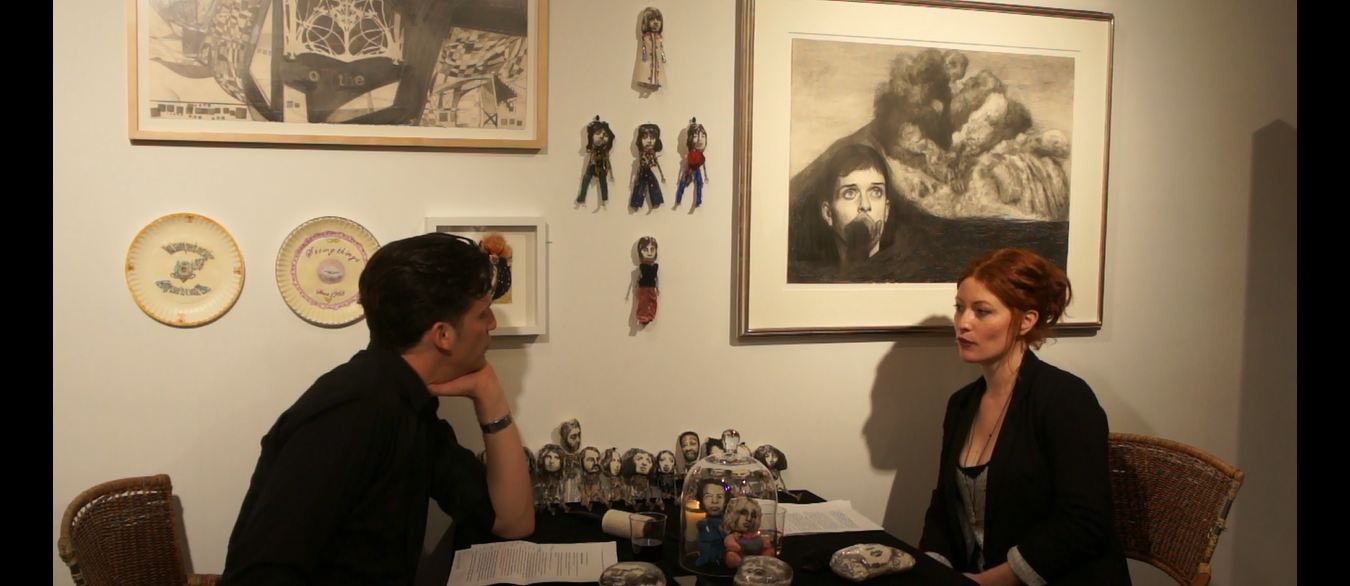Remember our coverage of Die Wunderkammer at The Lodge? Well, there was a brilliant talk between artists Hayley McCulloch and Paul Brainard. Unfortunately we didn’t get a chance to film the talk, but we did get our hands on a transcribed version of the talk via a shady, trench coat wearing stranger who threatened to kill us if we ever acknowledged their existence. So, without further ado, we present the Artist Salon with Hayley McCulloch and Paul Brainard.
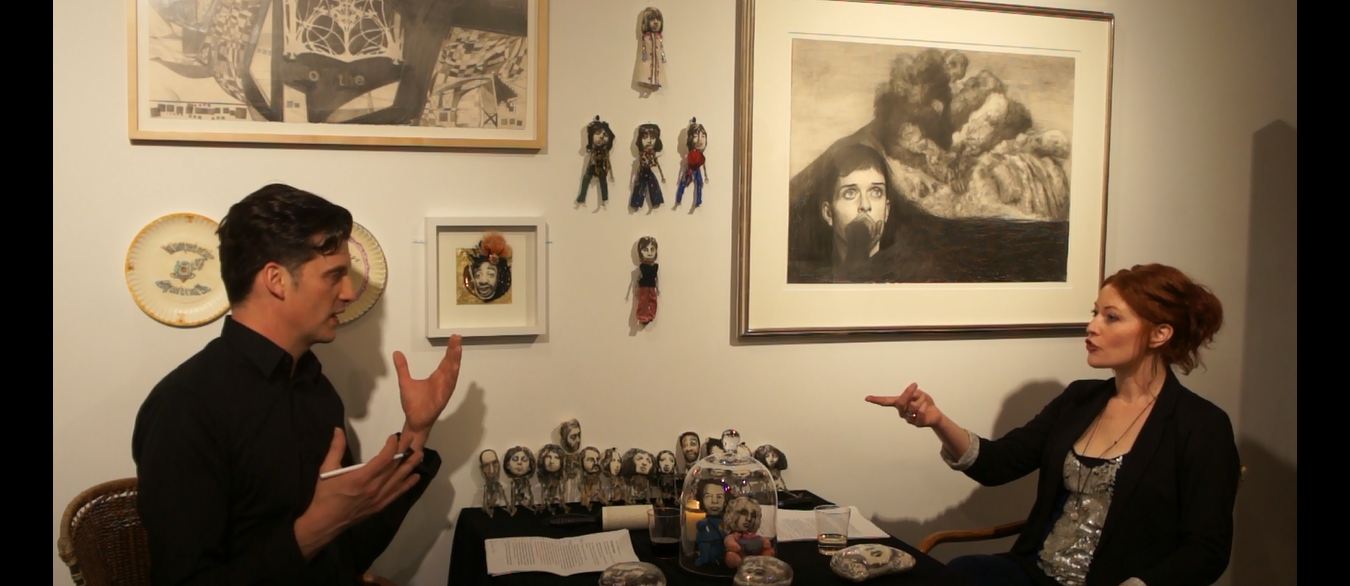
Courtesy of Hayley McCulloch.
Hayley McCulloch:
“We’re using a hairbrush and a lint brush as stand-ins for microphones, because we’re going to begin by talking about the on-going influence of particular vocalists and certain music in our work. I was naturally drawn to your drawing of Ian Curtis. A while ago, Jason (Jason Patrick Vogele-Republic Worldwide) had shown me an image of it, before I even met you. I know why I love it, and this was before I even heard the background story. Tell me a bit about it, how did it come to be?”
Paul Brainard:
“Well, the impetus for the “18 May 1980” drawing came to me while watching a nature program at home one evening. I was falling asleep during a piece on the Mount St. Helen’s explosion, when the narrator mentioned the date of the blast, and I woke up. I’m so familiar of the date of Ian Curtis’s suicide…I immediately made the connection. As I thought more about it, I considered the energy and electricity of life and what becomes of this energy after death. Because my father is a retired chemical engineer, I’ve always been aware of the first law of thermodynamics, which is, that energy cannot be created or destroyed, only transferred, therefore, one’s own energy after death, it has to go somewhere. It immediately made sense that I should make a drawing about this, about Ian, in conjunction with this explosive occurrence.”
Hayley McCulloch:
“I remember reading that Alexander Bell, or maybe it was Thomas Edison, would hold Chinese meditation balls in his hands before taking a nap, and when they fell to the floor, he’d usually wake up with a solution to a problem he’d been working on. The subconscious answer transpiring over the intellect.”
Paul Brainard:
“I pull from astrology; I sometimes reflect on certain dates with association to specific happenings. My thought process usually involves ideas that connect with planetary forces and in this case, how thermodynamics connects with existential despair.”

“Ian”. (Courtesy of Paul Brainard.)
Hayley McCulloch:
“I don’t keep an almanac, but I look these things up when I feel a strong inexplicable pull one way or another. I usually know in advance when it’s Mercury Retrograde. And, by the way it’s a new moon tonight; Republic Worldwide planned the talk to coincide with that. Light some candles and pour me another glass of wine, please.”
Paul Brainard:
“Sure! Yes, and you know, the music of the Joy Division, I think that it really appeals to a lot of artists, because it’s spatial, stripped down and position and place are clearly defined.”
Hayley McCulloch:
“Yeah, the figure has an outstanding place, in the soundscape – quiet stark and striking.”
Paul Brainard:
“Their music is almost skeletal.”
Hayley McCulloch:
“With a lot of punk music, it’s the essence of a driving force that makes me attracted. It reminds me of my pulsating existence. I also feel that way about hip hop. Look at ODB and Ian Curtis, they were carried away with what they had made. They were really taken from the usual patterns of depression and mania, and gainfully inhabited by this amazing stuff that they were channeling.”
Paul Brainard:
“Let me ask you this, why does Ol’ Dirty Bastard recur in some of your recent work?”
Hayley McCulloch:
“Well, I was captivated by his unbridled energy, his spirit appeals to me..he doesn’t seem to second guess. You know how his credo was along the lines of, ‘the world is dirty, so I’m going to be dirty too?’ I see it as a tribal practice, smearing mud and paint on yourself; it helps you combat your enemies and demons. We’re of the earth and we can draw grit from it. The challenge is not to be blighted by the oppressive forces of negative thinking, poverty, class wars or political deception. It’s funny, we’re talking about the whitest of white boys – Ian Curtis, from my neck of the woods, Manchester, England, and the blackest of black boys, being ODB aka, Russell Tyrone Jones, from Brooklyn, NY, and how in their oppositeness, they are very similar.
They were both raised in downtrodden environments, with working class backgrounds, with singular vision on a self made mythology. In my work he’s become a talisman, an amulet, to keep me moving. And this piece, ‘ODB in 1953,’ it’s really funny to me. He’s all fancied up in an old ladies headdress, gold leaf in the background, ready for a highfalutin ball. He’s almost certainly gonna spike their punch bowl.”
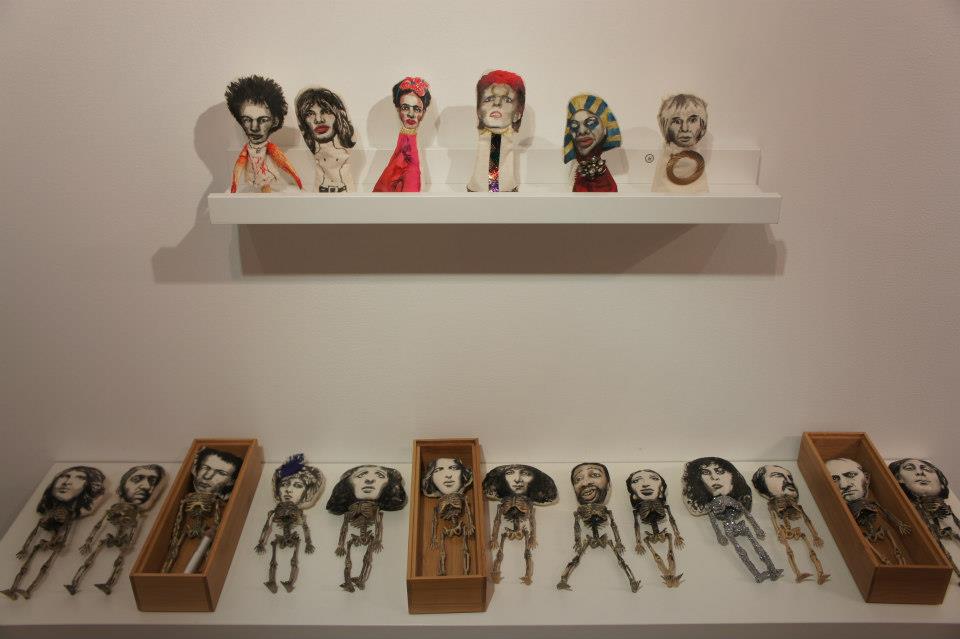
Courtesy of Hayley McCulloch.
Paul Brainard:
“And you know, they both had a tremendous sense of desperation. Both expound upon some kind of awkwardness, and vulnerability, but intensity too. They were also both Scorpio, well Curtis was Scorpio moon.”
Hayley McCulloch:
“Well, being receptive to the world within and without you, on a day to day basis, there can be an inherent desperation, being prone to that. The moments where I feel that I’m failing as an artist, or just as a properly motivated person, I can usually rely on certain music to propel me. Because, you know sometimes, when the living of this modern life is honestly examined, you might feel, “well something doesn’t feel quite right about this, I don’t feel so good about that,” so maybe you should make some art about it. It’s bound to come out a bit f*cked up. Go with it. It’s a practice. I often like messed up voices and rough sounding songs.”
Paul Brainard:
“Yes, you have to stick with it. I have a friend who’s a dancer, and dancers have a shorter shelf life. He’s an accountant too, and people ask him if he regretted putting so much time into dance, and he said yes, everyday. But you don’t have a choice. I want to say something else about astrology though. It’s rejected in the west, people think it’s bullshit…yes, it’s hokey if you get it from a bad source. But I can see a logic that’s really interesting to me, and there lies a big visual bank for me to draw from for my work. You don’t want to believe because it’s not scientific, fine. Some things are beyond you and are not explicable, right? You know, in whatever discipline, usually the first version is rejected and the second version is commoditized and accepted. The second version is not usually better.”
Hayley McCulloch:
“The negativity that weighs on our consciousness, it’s not good. It’s really no good for creatives. Back to ODB, when I watch recordings of his performances, he seems totally liberated from it all. It reigns above the powerlessness I sometimes feel in the down moments as artist, you know, the implied failure, involving being stumped, dealing with a deflated spirit or on-going financial difficulties, just basic lack of support or…
It’s real work to lift that heavy veil. He’s shamanic to me…you know in a lot of his videos, how he’s writhing around in this trance, Ian Curtis too, he’s staring out like a witness to some galactic understanding, shaking free in those mad dances; regardless of what drugs they may have been on, certain drugs lend service to higher ritualistic purpose. Duende reaches inside from the souls of the feet, and withdraws your spirit. I recognize and implement what I feel there..both of these guys have the courage to just be out there all flawed and flaying around through all the good and bad. I love them, for those reasons.”
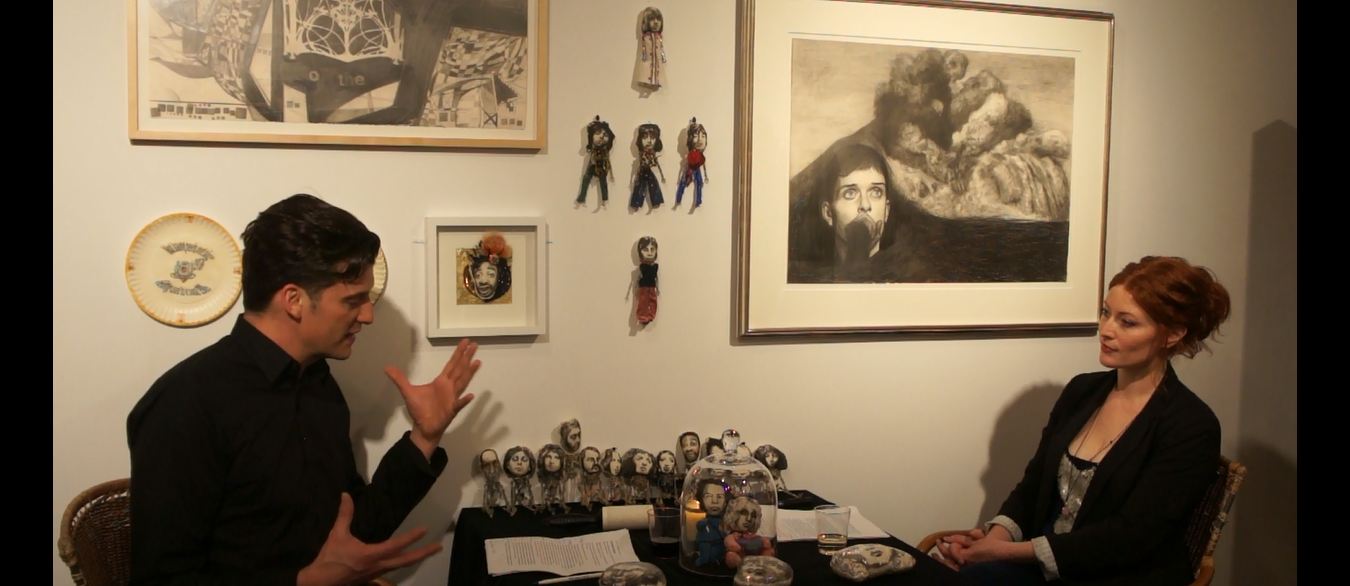
Courtesy of Hayley McCulloch.
Paul Brainard:
“You were quick to correct, when it was written in a press release, that you would NOT be talking about your fascination with celebrity and death… why?”
Hayley McCulloch:
“Because I’m not fascinated with these things. I got a little riled up when I read that. Celebrity to me is synonymous with elitism, and infers something untouchable, surface and shiny, hostile, moneyed and smug..a celebration of separateness. The ‘importance’ of ‘celebrity culture,’ has been designed and inflated by the media. Now someone, say, Helen Mirren for example, is beyond this negative association for me. She’s a great actress first, public figure second. Was Buster Keaton a celebrity? He was an artist. I’d say when entertainment is synonymous with insight, it’s based around a philosophy of performing astute observations regarding the human condition, it’s enriching.
I’m interested in merit, ingenuity, those who are climbing or have risen the heights of their craft with almost supernatural wit and dedication to their calling through thrashing it out and honing their insights, implementing talent and focus. It’s not idolatry, but a deep fascination with the indomitable spirit.”
Paul Brainard:
“My first love and first real girlfriend was an opera singer, a mezzo soprano who also had a wide breadth of musical tastes. I absorbed a lot of my tastes from people who were very well versed in diverse musicality. My parents were very influential, with everything from Mahler to ABBA to Morton Subotnick the avant garde electronic composer.”
Hayley McCulloch:
“People with creative resilience, I want to keep them close, and sad as it may sound, well, the dead, famous ones, they’ve been a substitute for friends and confidants, and will probably continue to be. We all felt like this at some point, with a certain writer or musician as we were growing up in a world that was weird to us. I’m interested in popular culture on a primitive level, with the luminaries who are able to pull it off by capturing the ephemeral or really funny stuff that makes life worth living. They help me push through the dumber and duller moments of being a human and an artist.”
Paul Brainard:
“How about your sculptures, next to us on the table. There’s Burroughs, Kerouac, Wilde, Sid Vicious, Edith Piaf, just to name a few.”
Hayley McCulloch:
“I was making a meditation on something beyond the ‘deadness’ in life, how your mind and soul can become flattened by this awful machinery comprised of commercial nonsense, where buffoons are bankrolled to rope you into their game, into the quagmire of mental and societal problems…and I cleave from all of this with “Les Petite Mortes,” I celebrate them as opposing all of that utter crap. “La petite mort” is “the little death,” the moments after orgasm when you feel released, emptied out of this world. These artists depicted were inclusive to their fellow humans, I mean, bent on publishing the struggle and joy of the human spirit. Sharing. They lift me from feelings of separation and anxiety, their work has protected me from the sometimes crushing mundanity and sorrow of life.
In this way, in this series, they’re like the relics of saints, more than voodoo effigies, which they could easily be taken for. In making them, there’s an aim to preserve something valuable along with an invocation to know myself, through what I love and understand, so I see them as talismans. I strayed from figurative work and portraiture for years. I always thought, “I see people everywhere, every day, I’m sick of the corporal,” but then I was drawn to this when I revisited some of my childhood icons. Looking at photos of their faces, I loved their faces again, because they are reflections of their inner lives. I identify with their investment in their art – their interest plays in their eyes. In those moments where they’re performing at their best, (or even worst,) they are standing (or falling) for other worlds that I felt I also knew about. To hear and see Maria Callas perform, or Iggy Pop or to watch Bill Withers sing “Ain’t no sunshine when she’s gone.” Wow…
But let me ask you something, do you feel like your work has a congruency that you are not always an immediate witness to? And also, do you feel like there is an overarching theme of spirituality made in your work, which protects you from the morass of daily life?”
Paul Brainard:
“I do think that the process of art making is for me a bit like driving in the dark, a leap of faith. The first show that I curated for Greenberg Van Doren Gallery, I named “True Faith,” borrowing the title from the New Order song and the idea of intuitively following a path in art making where it is open ended and that the final result is something that is arrived at rather than dictated from the start. I enjoy many art forms that operate in this manner and I think that the end result is fascinating when it has a sense of improvisation in its creation. We discussed in conversation the idea that the making of artwork is a therapeutic way in which the the artist deals with the boring aspects of existence, it is as we are arming ourselves against lameness in general.
It is not as if artists have a choice in the matter, we are using our sensitivity to filter everyday survival and create something out of what we are given. By making art, I’m leaving a record of my existence, a voice that transcends death. Time and energy are compressed into each artwork, the psychic energy that goes into one artwork very concentrated and intense. The process of drawing is a process of unconscious meditation where I feel remotely present, at the end of this meditation a drawing the record of that ritual.”
Hayley McCulloch:
“Yeah, I like that… it’s not prescribed, but rather transcribed. My ‘art statement,’ if I have to write one, comes after the journey of the making. Heart and soul forays to adventure, often leading into dimly lit places, at the time, unknown to the self. Being roughly the same age, we’ve talked about our love of some of the music of the early eighties, and the language of longing. Pop music with themes of aching and sensuality…not heard much in pop music today. I return to it. I feel that I don’t want it to be cleared out in the forest fire of hit-making caterwauling corporate junk. I wonder why I have a history of being drawn to so-called rebellious icons, and I think that it’s simply because they have little or no concern for the mandates laid in front of them. For me, naturally questioning order and taking things to task through deconstruction and experimentation, is where the soul comes through, and that’s where ingenuity and cultural advancement takes place.”
Paul Brainard:
I feel very fortunate for the time that I grew up in the early 1980’s is an amazing time of very different kinds of underground music. A lot of the music that was early on MTV, in its first few years was wide open, very low budget, and very exciting to see. I am a huge fan of many different kinds of music from the 1970’s and 1980’s and I think that there are so many kinds of music from which the subcultures grew in their own special areas and were allowed to develop in a way that is not possible now. Siouxsie and the Banshees in particular were an amazing combination of true feminism and female power that takes a direct stance without preaching. She is a powerful feminist icon and the music is timeless. I think they have reached an apex that has yet to be surpassed.
Here are a list of some of my favorites in many disparate areas of music from that time. The Smiths, Joy Division, New Order, Siouxsie and the Banshees, Adam and the Ants, Kraftwerk, Miles Davis, Duran Duran, the Plasmatics, Wire, Motörhead, Metallica, Public Enemy, Discharge, The Sex Pistols, Big Black, Scratch Acid, The Butthole Surfers, Naked Raygun, Government Issue, The Misfits, SSD, Negative Approach, Minor Threat, Eric B and Rakim, EPMD, Anthrax, Exodus, Led Zepplin, The Gun Club, Killing Joke, The Power Station, The Police, , Missing Persons, Pink Floyd, Slayer, Thin Lizzy, U2, Judas Priest, Iron Maiden, Deep Purple, Black Sabbath, Rainbow, Black Flag, The Fixx, Celtic Frost, Can, The Birthday Party, The Clash, AC/DC Bad Brains, Billy Idol, Corrosion of Conformity, Colin Newman, Fela Kuti, Gang of Four, Motley Crue… It’s bloody endless, I could go on forever.”
Hayley McCulloch:
“I’m with you on most of those, make me a mix tape will you? Just to name a few, I adored Duran Duran, Adam Ant, Roxy Music, Grace Jones, Kate Bush – As a pre-teen, this is before literature, before art and sex and everything. Hormones are raging, curiosities and interests are blossoming at this point, for almost everybody. These pop stars were the only poets I knew or understood, before the age of 11. Their particular synthesis of music, fashion, theater and mythology was something to be identified with immediately. I adopted their power as my power. I didn’t know what I was doing at the time, but that song by Siouxsie And The Banshees, ‘Spellbound,’ and ‘Stand and Deliver,’ by Adam And the Ants, I remember ceremoniously playing them in my head to help me focus and win at sprint races and hurdle jumping, on “Sports Day,” at primary school. They still give me power to overcome my unmotivated ass, overcome the affront of the blank canvas, to break through the despair of it all. It’s unadulterated magic.”
Paul Brainard:
“I can’t believe some of the lyrics that were written around this time…just absolute poetry and really amazing non PC stuff like time. “Arabian Knights,” a song by Siouxsie and the Banshees, where she is just totally condemning the sexual violence and predatory nature of groups of men in the Middle East. I mean, it’s heavy: “Veiled behind screens, kept as your baby machine, whilst you conquer more orifices, of boys, goats and things, ripped out sheeps eyes-no forks or knives” Woah!”
Hayley Mcculloch:
“She’s amazing. Loads of pagan imagery too in so much music of that time. Unless it was an ‘art’ or ‘underground’ thing, these days, I can’t really imagine hearing that kind of lyric in widely publicized pop music, but then, it was a smash hit. Aside from these pop cultural references, how do you feel the effects of Catholicism have influenced your work?”
Paul Brainard:
“I think that a lot of the imagery I have used in the drawings especially the more explicit work i am directly dealing with things that persist because of being raised catholic. The imagery of the Catholic church, the ritual of the mass, the morbid ritual of the body and blood of Christ. A lot of the work centers around sex and death themes, at least a lot of the more referential work. I made a lot of work which was obnoxiously overtly sexual, because of the fact that the Catholic church is so atrocious in its inability to be able to address this most basic human impulse. The counterculture of punk rock and thrash metal and its rebellion against organized religion, and specifically Catholicism, was something that all came together for me, at 15 years old, and it still has resonance.
When I was in high school around this age, I was extremely cocky and was not happy with my school, the church or society at large. I met a girl who was also rebelling against catholic school, her parents and society. We used to skip school and get drunk together and listen to punk rock and metal and make out. Really, so much of where I am coming from as an artist was formed in this time. What about you?”
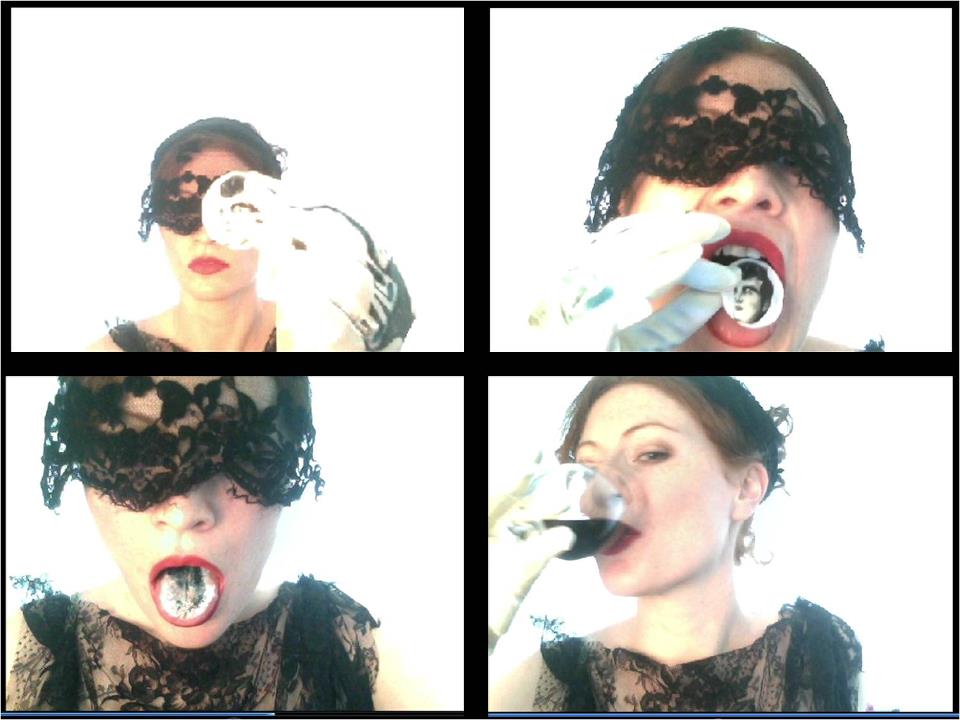
Still from The Communion Series. (Courtesy of Hayley McCulloch.)
Hayley McCulloch:
I see it in my work, and it’s not immediately conscious or confrontational, but it reveals itself to me later. Like a Hydra, the many-headed monster, it’s a persistent, multifaceted problem that can’t be chopped off completely by a single effort. Ugly stuff pops up from time to time. I was one of only three kids who were non-catholic, in a very strict, not very compassionate, Roman Catholic school. The other two kids actually had a religion, they were Muslim and Sikh. We were targeted and ostracized. I was the only red-headed kid in that trio too..boy, did they have it out for me.
In ‘The Communion,’ 2012, it later became apparent to me, I was making the ceremony on my terms, because I was not allowed to take it in church, because I wasn’t baptized and had been through the first Holy Communion ceremony. I made a fake edible LSD sheet around the same time as this too, that also featured the faces of musicians. The nuns were twisted and the priests were god awful people. The primary school that I went to was the worst, you were supposed to be reverent to these nonces, the ones ordained above YOU, to absolve YOU from your sins. You’re 5 years old for f*cks sake! I never understood what they were banging on about. I got that ‘higher power’ stuff from music, literature and art really, and later by reading about transcendentalism.
When I heard Nina Simone, I knew it. Nobody sang like that in a Catholic church. That woman was a spiritualist, and it’s got everything to do with emoting a superhuman voice, it reaches right through life and beyond death. We’re all in this together, start reaching out. I never responded to the stoicism and the guilt inherent in organized religion, or to the authority of the man in the cloth..well unless the cloth was sequined tiger print and the man in it, was Bryan Ferry. Were you baptized?”
Paul Brainard:
“Yeah, I was… I remember one of the students asking one of the sisters, “Well I don’t understand, what do we do if we’re walking down the street and we see some really hot girl, what are you supposed to think about, cookies?” She threw him out, she wouldn’t even answer his question.”
Hayley McCulloch:
(bursts out laughing) “She should have said, (adopts uppity elderly British nun voice) ‘You should think about me, young man!'”
Paul Brainard:
“Oh my god. Yeah! She was not attractive.”
Hayley McCulloch:
“You said something interesting the other night, and I’m paraphrasing, that you became an artist because you’re a natural philosopher, that being an artist was an answer to being a natural philosopher. I like that… do you want to say more? You also said that death is the base image in all of your work.”
Paul Brainard:
“I do think that the prime motivation in making art for me has always been the finite existence that we all struggle with as human beings. I don’t think that other animals are confronted with existential terror in the same neurotic way. Death has always been in forefront of my mind, I am not sure where the origin of this lies or if it can be pin pointed. I have become more aware of the shortness of life the older I get.
The passing of time alters one’s perception of time itself, what is a year to a 5 year old is much longer than a year to a 65 year old. Objectively time is the same but our relation to it changes. In my work I am drawing out unconscious maps of my head, drawing out the world that I am submerged in my life in New York City. Confusing signage and very personal things mix with the generic images of mundane existence, and so abstraction mixes with more representational imagery in the same manner.”
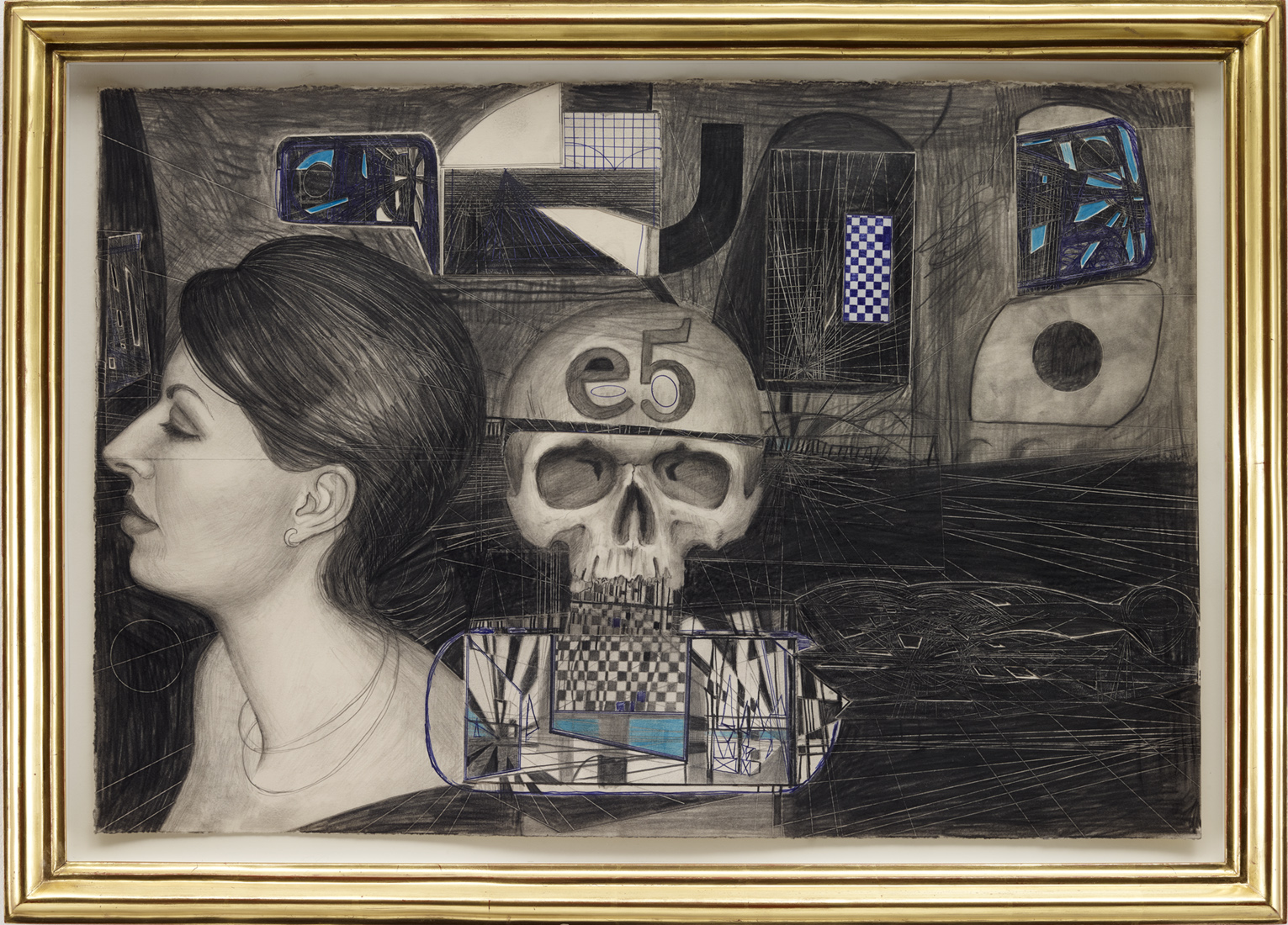
No Credit, No Future, No Problem. (Courtesy of Paul Brainard.)
Hayley McCulloch:
“It’s involuntary, death, and birth – what I can say about them, in life, is voluntary. That’s the only power that I have in-between these occurrences. It’s a strong guide to direct you towards what’s important, the visceral underpinning of everyday living movements. More often than not these days, this acute awareness, presides over my work. Why would it not be the crux of my work? But I’ll tell you something, that’s why comedy is prevalent in my work. It seems to spring up again, helps me define life more clearly, like a silly and violent force against death. A vital antidote to the sometimes crippling thought about the final tragedy of existence.”
Paul Brainard:
“In my paintings and drawings, compositional elements refer simultaneously to deep space and surface arrangement. This formal device reflects the position of one’s reality, the gulf between where one exists in their mind as opposed to the reality of one’s existence. Many perspectives simultaneously occur within one work, and you can see that both abstraction and representation push and pull off of one another to develop a dynamic within the drawing that captures the void of substance in everyday life. The emotional despair in the drawings stem from a distinct lack of spirituality that is very representative of today’s society.”
Hayley McCulloch:
“You were a teacher, you taught 4 years-olds, and you told me that you started giving them lessons beyond their scope to see what would happen, discovering that they painted the most extraordinary things, with weird perspectives, and that it was great for you to be influenced by this. I thought of Art Brut and Jean Dubuffet and his collection of work by children and the mentally ill. Your work is very technical and has a lot tension, to me, it’s pretty diametric to naive or outsider art…yet you have a yearning for wildness. In your current work, would you say that this drawing restraint defines a lifelong style for you?”
Paul Brainard:
“I can remember teaching younger children and trying to teach them a lesson beyond their scope, because I was curious to see what they would come up with in their mistakes. I found these ‘errors’ to be fascinating because they pointed to a direction of new ideas. The misinterpretation of the lesson is exactly the source of new growth, and in getting it ‘wrong,’ they showed me a new way to proceed. In my own work I like to push and pull off the tension that occurs with precision vs. expression. I like this dynamic, and I am always drawn to work that has this kind of diversity implied in its formal process. You should be sensitive enough to what everyone’s needs are, enough that you are listening to what they’re saying, and then kind of angle them in a direction that’s most beneficial..that’s good for artists, and that’s the way some of these religions should be operating. It’s something I learnt in an education classes, it seems obvious and good to do this.”
Hayley McCulloch:
“What? Oh, we’re getting the signal to wrap it up. There’s a big sexy birthday party coming through to Fig 19… Should we have ended this with a couple of karaoke numbers?”
Paul Brainard:
“We’ve still got the hair brush and the lint brush…”
Hayley McCulloch:
“Let’s take it to the back room then, I actually think that I hear some amazing music playing back there.”

Quiet Lunch is a grassroot online publication that seeks to promote various aspects of life and culture with a loving, but brute, educational tinge. When we say, “Creative Sustenance Daily,” we mean it.

